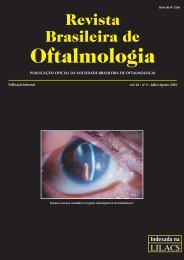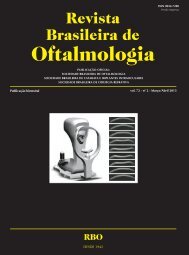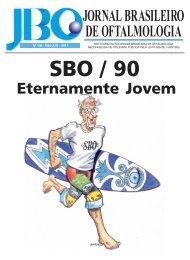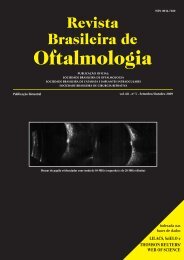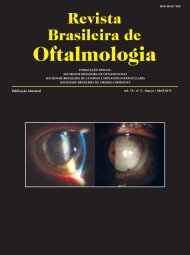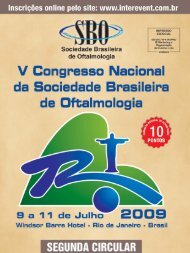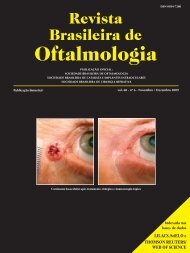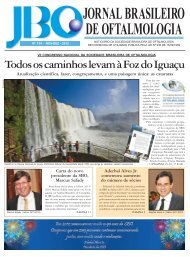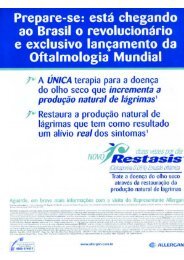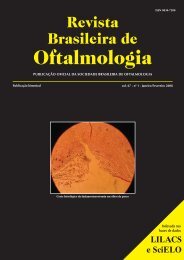Biometria ultrassônica no cálculo do po<strong>de</strong>r dióptrico <strong>de</strong> lentes intraoculares: estudo comparativo dos métodos...215CONCLUSÃOOs dados <strong>de</strong>ste estudo evi<strong>de</strong>nciam precisão ereprodutibilida<strong>de</strong> dos resultados, e permitem concluir queo método <strong>de</strong> imersão é mais preciso e apresenta maiorconfiabilida<strong>de</strong>, po<strong>de</strong>ndo evitar erros no cálculo do po<strong>de</strong>rdióptrico da LIO e consequente insatisfação visual dopaciente no pós-operatório da cirurgia <strong>de</strong> catarata.Como se verificou diferenças significativas nosdois métodos, sugere-se a<strong>de</strong>quação das diversas fórmulas<strong>de</strong> cálculo <strong>de</strong> LIO para a técnica <strong>de</strong> imersão, já queas fórmulas usadas atualmente foram baseadas principalmenteem dados ecobiométricos <strong>de</strong> contato.ABSTRACTPurpose: To compare the ultrasound biometrymeasurements between immersion and contact techniques.Methods: The biometry was ma<strong>de</strong> in 60 eyes by the sameexaminer, using the contact and immersion techniques ineach eye. Results: The lower mean axial length (23,16 mm)was found in the contact technique, and the greater (23,29)was found in the immersion technique, using the same probe.The lower mean standard <strong>de</strong>viation between recurrentmeasures in the same eye was found in the immersiontechnique, and the greater in the contact procedure, andwas found statistically significant (p
216ARTIGO ORIGINALComparison between OPD-scan results andcontrast sensitivity of three intraocular lenses:spheric AcrySof SN60AT, aspheric AcrySofSN60WF and multifocal AcrySof Restor lensEstudo comparativo da análise <strong>de</strong> frente <strong>de</strong> ondae sensibilida<strong>de</strong> ao contraste entre as lentes intra-ocularesmultifocal AcrySof Restor SN60D3, monofocal AcrySofSN60WF asférica e a monofocal SN60AT esféricaCelso Takashi Nakano 1 , Wilson Takashi Hida 1 , Newton Kara-Jose Junior 3 , Antonio Francisco Pimenta Motta 1 ,Danilo Fante 2 , Victor Ferreira Masson 2 , Alexandre Reis 2 , Mauricio Pamplona 2 , Iris <strong>de</strong> Souza Yamane 1 ,Ricardo Holzchuh 3 , Amaryllis Avakian 3ABSTRACTPurpose: Compare the OPD-scan results and the contrast sensitivity in patients who hadimplantation of the AcrySof SN60D3 multifocal IOL, the AcrySof SA60AT spheric monofocalIOL and the AcrySof SN60AT aspheric monofocal IOL. Methods: Thirty-two eyes receivedthe multifocal IOL, 32 eyes received the spheric monofocal IOL and 32 eyes received theaspheric monofocal IOL. They were closely paired in age, sex, pre-operative wavefront analysisand contrast sensitivity. All patients was tested with the OPD-scan aberrometer, ETDRS chartat 100% and 9% contrasts and contrast sensitivity. Results: Statistically significant differenceswere <strong>de</strong>tected more total aberration in SN60AT group (KW = 9.42; p=0.009) when comparedto SN60D3 group (p=0.016) and SN60WF group (p=0.0047). The SN60AT group (KW = 16.20;p=0.0003) showed with high spherical aberration values compared to the SN60WF (p=0.00046)and SN60D3 (p=0.0014) group. No significant differences were found between groups in fardistanceVA measured using ETDRS at 100% and 9% contrast. The SN60D3 group comparedto SN60AT group (p=0.016) had low contrast sensitivity (log units) with statistical differencein 6.0 cpd (KW = 7.84; p=0.0199), but no statistical difference between SN60WF and SN60ATgroup (p=0.91) and SN60WF and SN60D3 group (p=0.051). The SN60D3 group had lowcontrast sensitivity performed un<strong>de</strong>r mesopic conditions (KW = 10.79; p=0,0045) in 6cpdspatial frequency compared to the SN60AT group (p=0.011) and to the SN60WF group(p=0.007) with statistical significant differences. Conclusion: In all analyzed parameters ofOPD-scan aberrometry the aspheric and the multifocal IOLs provi<strong>de</strong>d less total and sphericalaberrations than spheric IOLs. All IOLs provi<strong>de</strong>d an excellent high and low contrasts vision,the multifocal IOL was as good as the spheric and aspheric monofocal IOLs.Keywords: Lenses; Lenses, intraocular; Contrast sensitivity; Phacoemulsification; Vision1Estagiário do Setor <strong>de</strong> Catarata do Hospital das Clínicas da Universida<strong>de</strong> <strong>de</strong> São Paulo – USP – São Paulo (SP), Brasil;2Resi<strong>de</strong>nte do Hospital das Clínicas da Universida<strong>de</strong> <strong>de</strong> São Paulo – USP - São Paulo (SP), Brasil;3Chefe do Setor <strong>de</strong> Catarata do Hospital das Clínicas da Faculda<strong>de</strong> <strong>de</strong> Medicina da Universida<strong>de</strong> <strong>de</strong> São Paulo – USP – São Paulo(SP), Brasil.Trabalho realizado na Faculda<strong>de</strong> <strong>de</strong> Medicina da Universida<strong>de</strong> <strong>de</strong> São Paulo – USP – São Paulo (SP), Brasil.Recebido para publicação em: 28/12/2008 - Aceito para publicação em 28/7/2009Rev Bras Oftalmol. 2009; 68 (4): 216-22
- Page 3 and 4: 192Revista Brasileira de Oftalmolog
- Page 5 and 6: 194212 Biometria ultrassônica no c
- Page 7 and 8: 196Novidades na cirurgia de catarat
- Page 11 and 12: 200Leonor ACI, Dalfré JT, Moreira
- Page 13 and 14: 202Santhiago MR, Monica LAM, Kara-J
- Page 15 and 16: 204Santhiago MR, Monica LAM, Kara-J
- Page 17 and 18: 206ARTIGO ORIGINALPrevalência de i
- Page 19 and 20: 208Machado MO, Fraga DS, Floriano J
- Page 21 and 22: 210Machado MO, Fraga DS, Floriano J
- Page 23 and 24: 212ARTIGO ORIGINALBiometria ultrass
- Page 25: 214Martins FCR, Miyaji ME, Lima VL,
- Page 29 and 30: 218Nakano CT, Hida WT, Kara-Jose Ju
- Page 31 and 32: 220Nakano CT, Hida WT, Kara-Jose Ju
- Page 33 and 34: 222Nakano CT, Hida WT, Kara-Jose Ju
- Page 35 and 36: 224Passos AF, Kiefer K, Amador RCIN
- Page 37 and 38: 226Passos AF, Kiefer K, Amador RCAF
- Page 39 and 40: 228Passos AF, Kiefer K, Amador RCde
- Page 41 and 42: 230Passos AF, Kiefer K, Amador RC32
- Page 43 and 44: 232Damasceno EF, Damasceno NAP, Cos
- Page 45 and 46: 234Damasceno EF, Damasceno NAP, Cos
- Page 47 and 48: 236Damasceno EF, Damasceno NAP, Cos
- Page 49 and 50: 238Marback EF, Pereira FF, Galvão
- Page 51 and 52: 240Marback EF, Pereira FF, Galvão
- Page 53 and 54: 242Aragão REM, Barreira IMA, Bezer
- Page 55 and 56: 244Aragão REM, Barreira IMA, Bezer
- Page 57 and 58: 246Sardinha M, Mendes Junior ES, Br
- Page 59 and 60: 248Sardinha M, Mendes Junior ES, Br
- Page 61 and 62: 250Instruções aos autoresA Revist
- Page 63: 252RevistaBrasileira deOftalmologia



